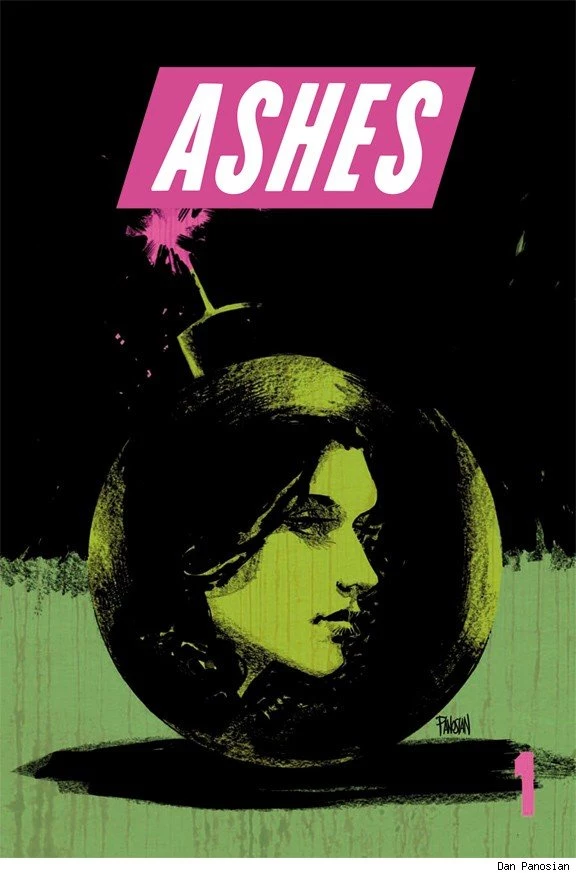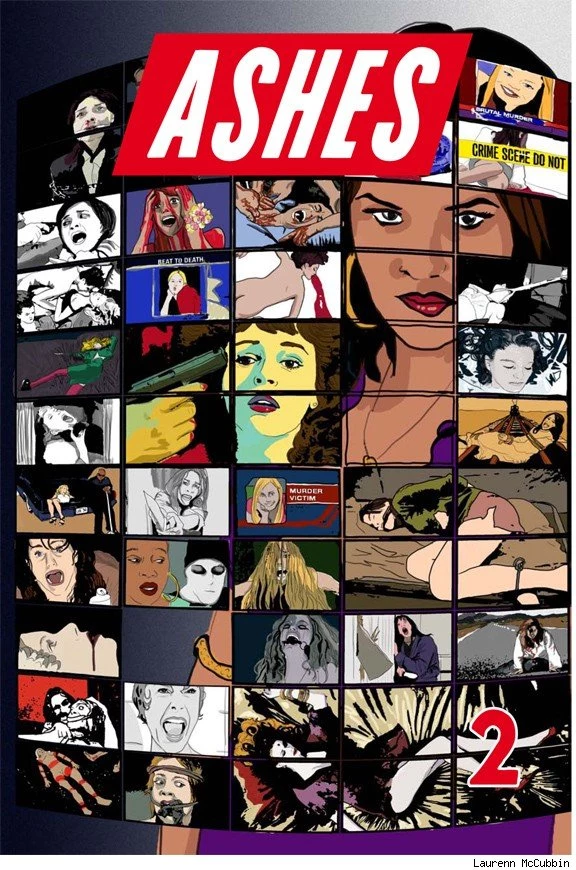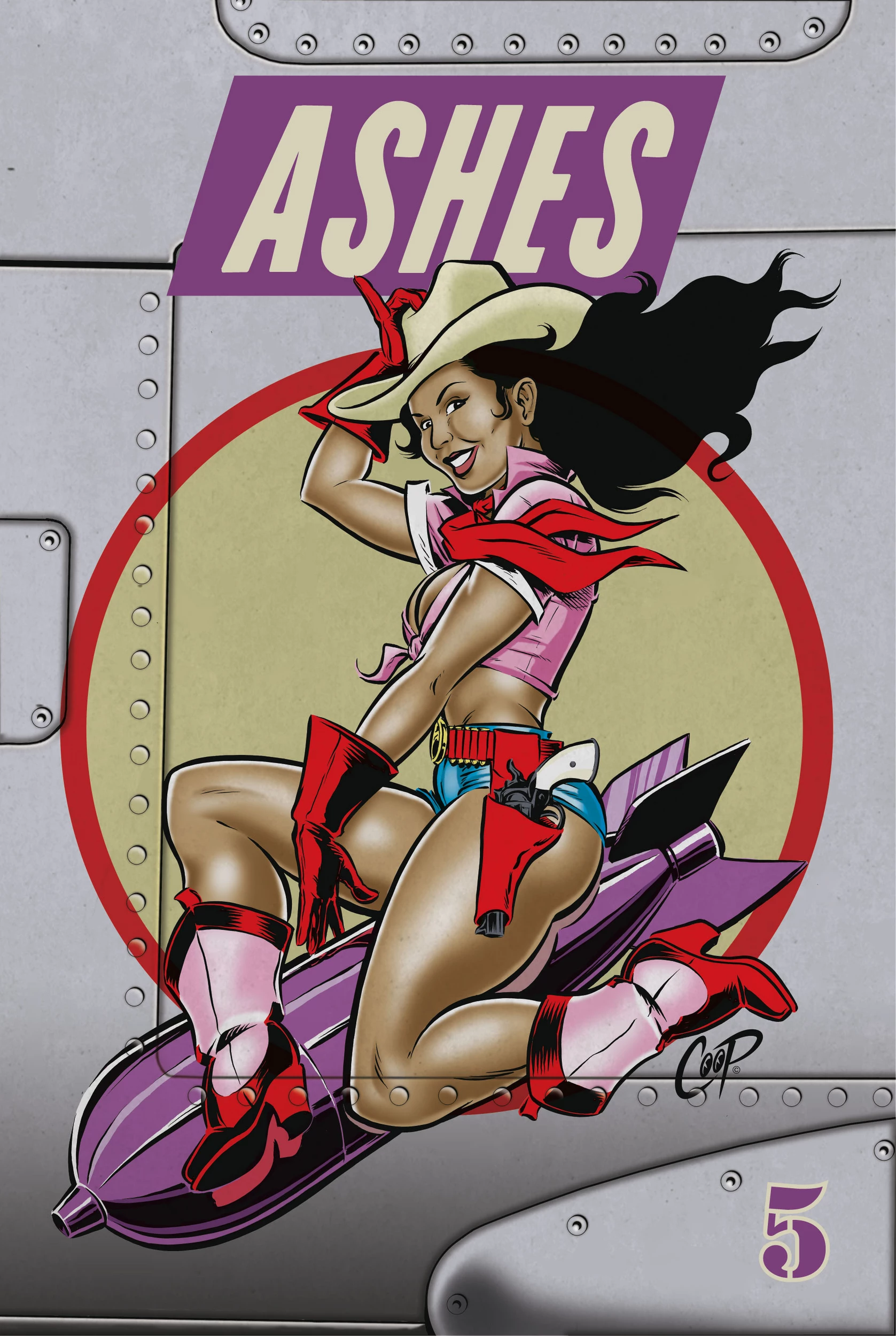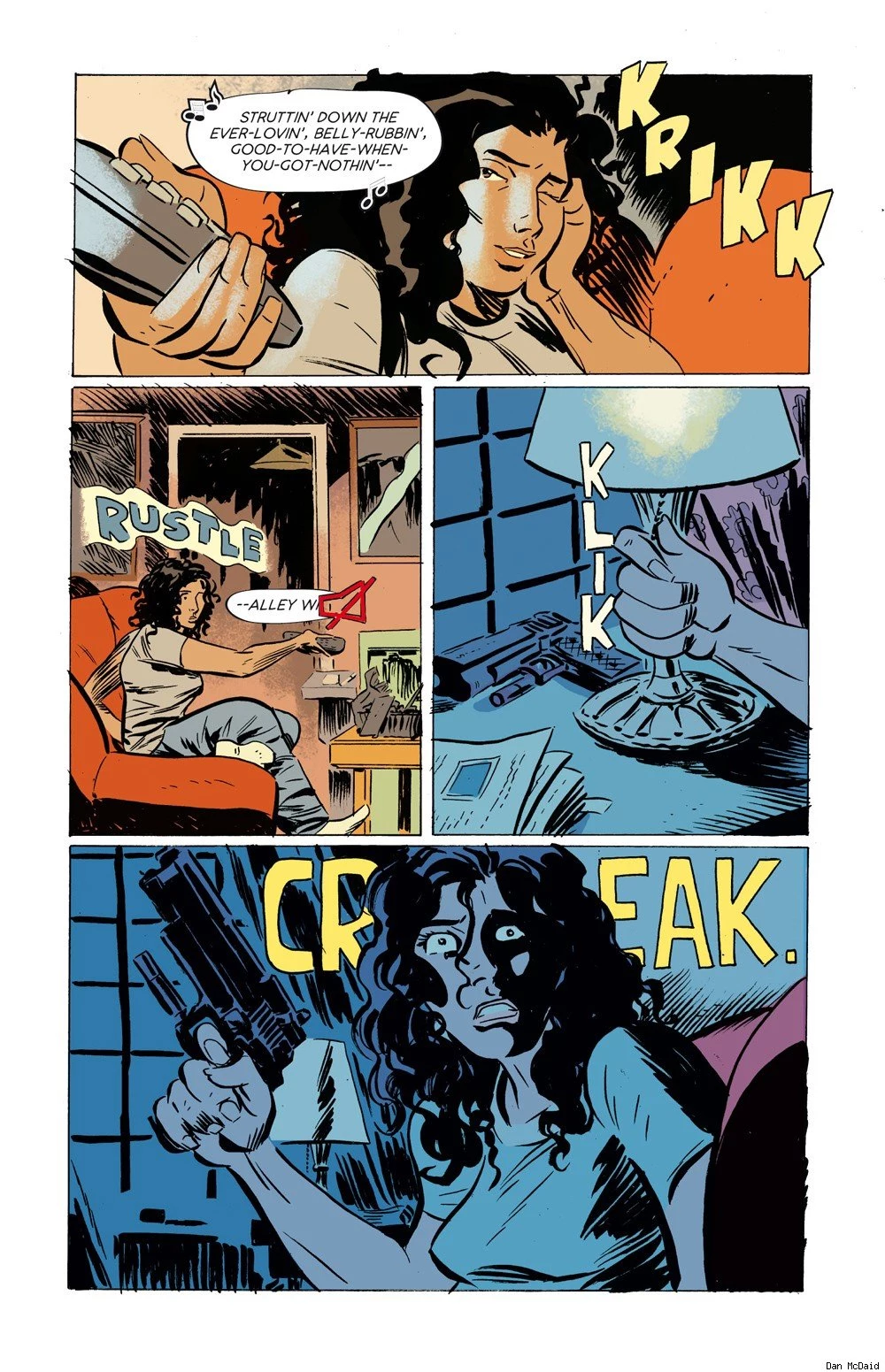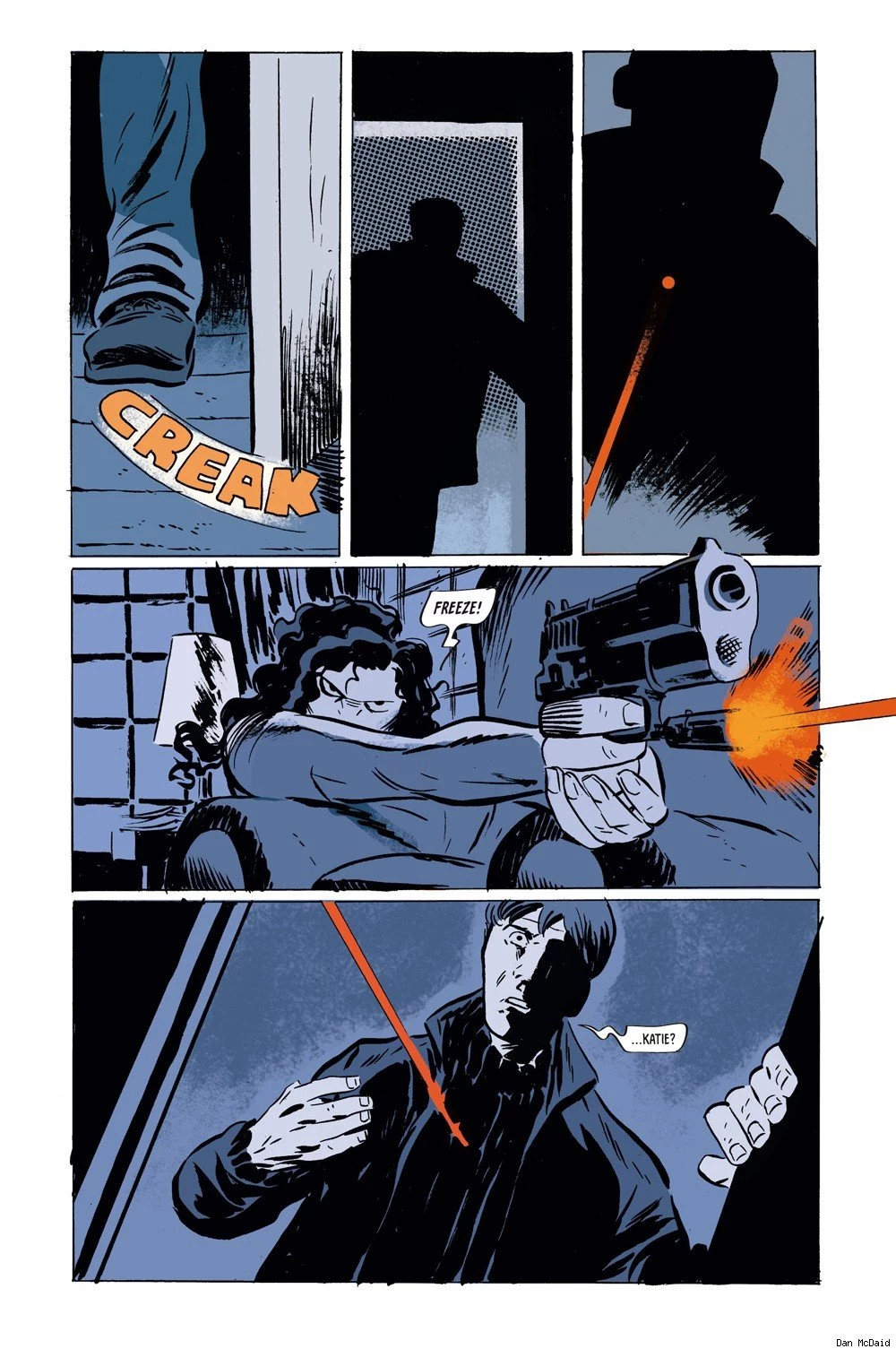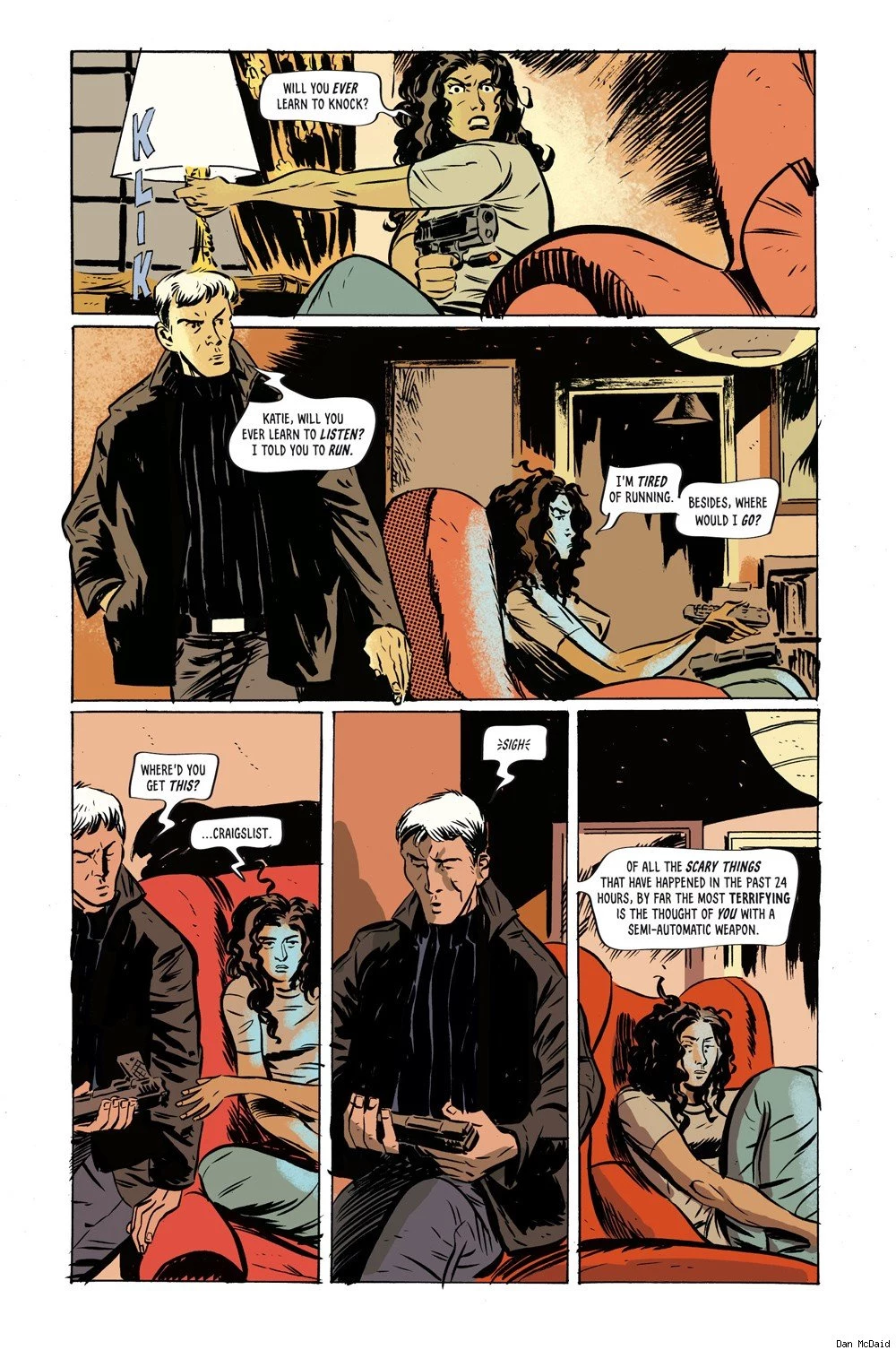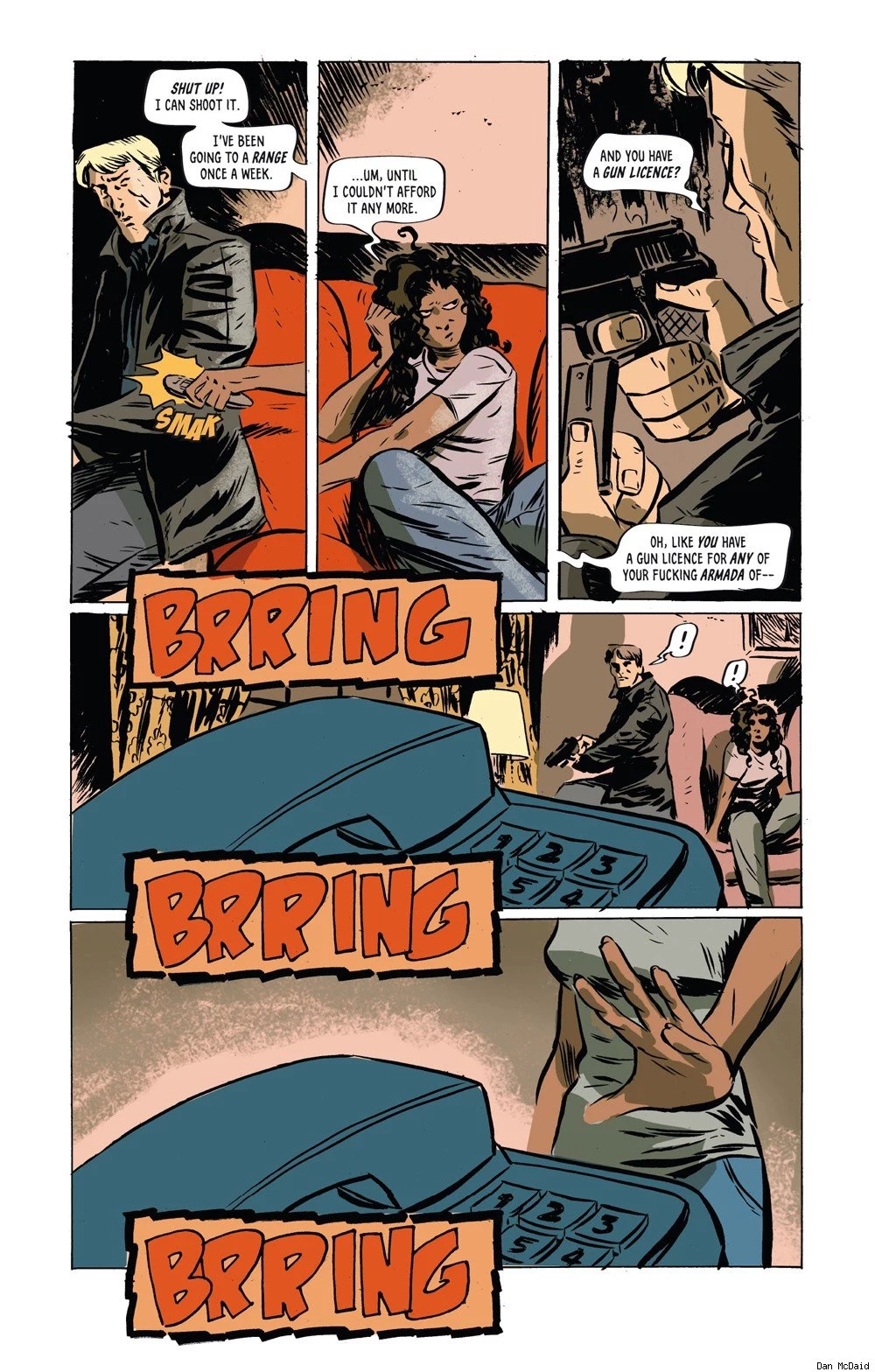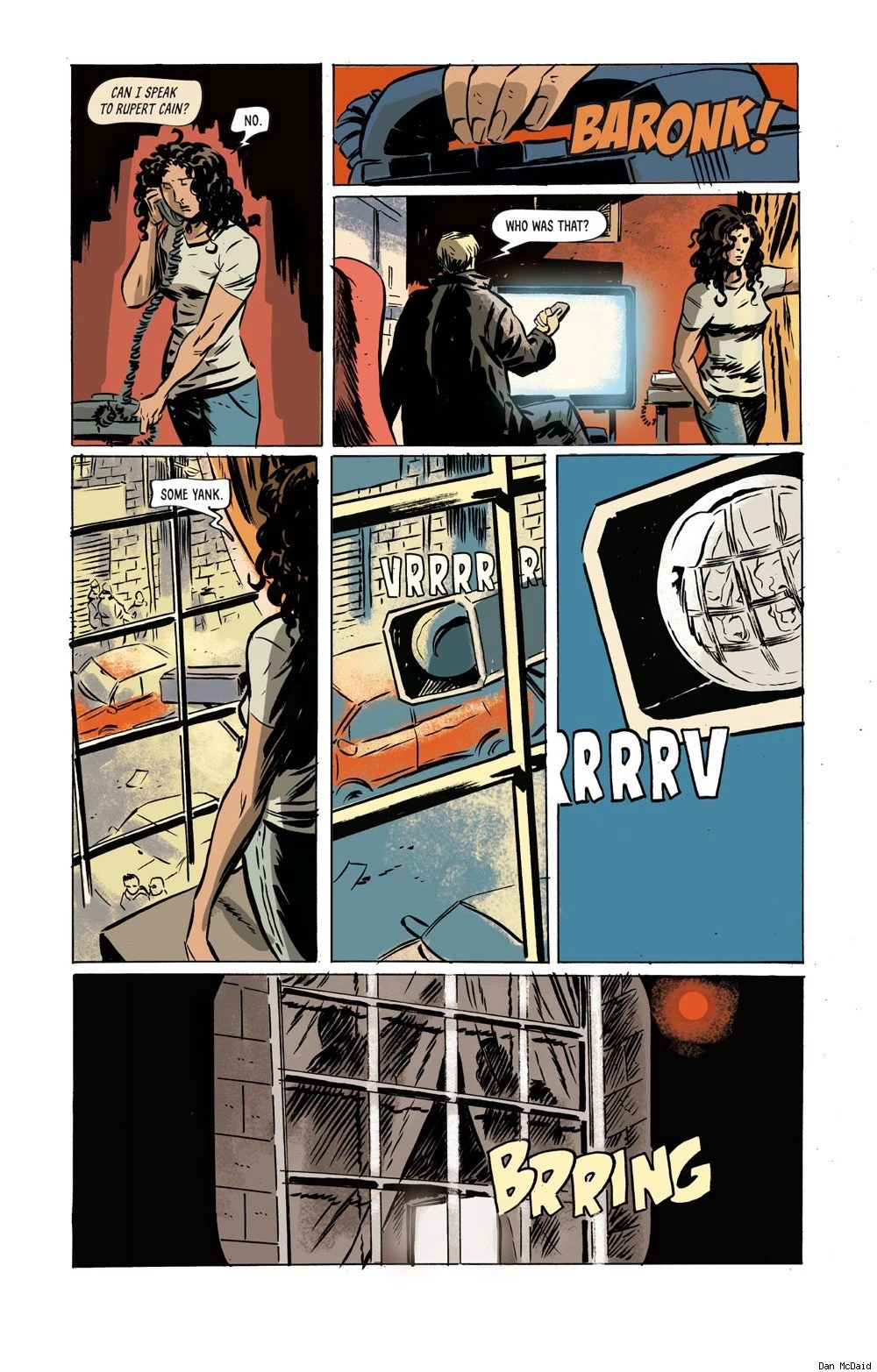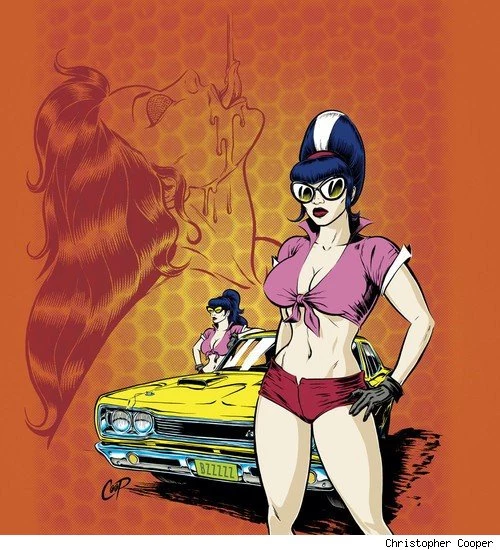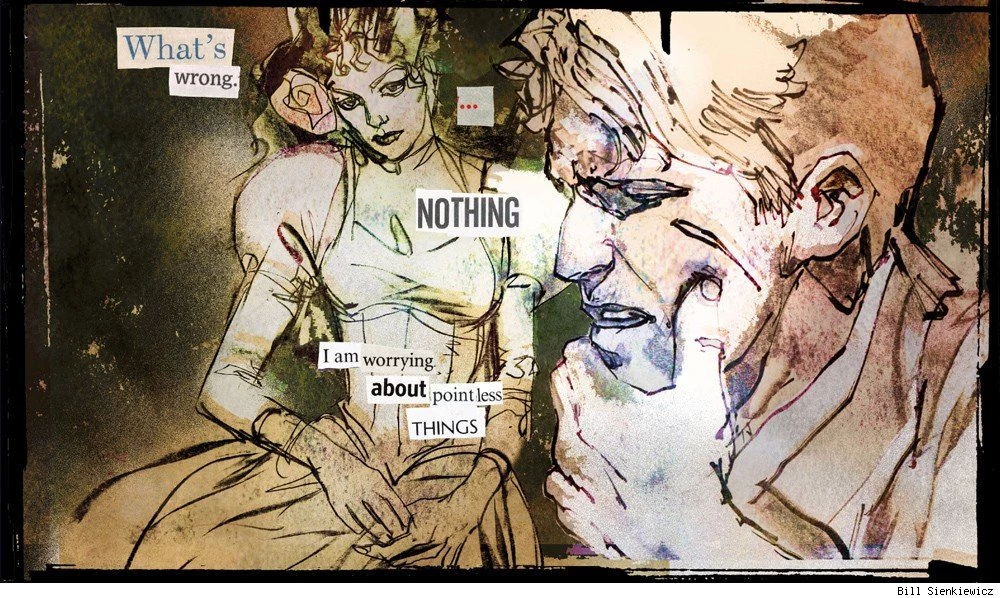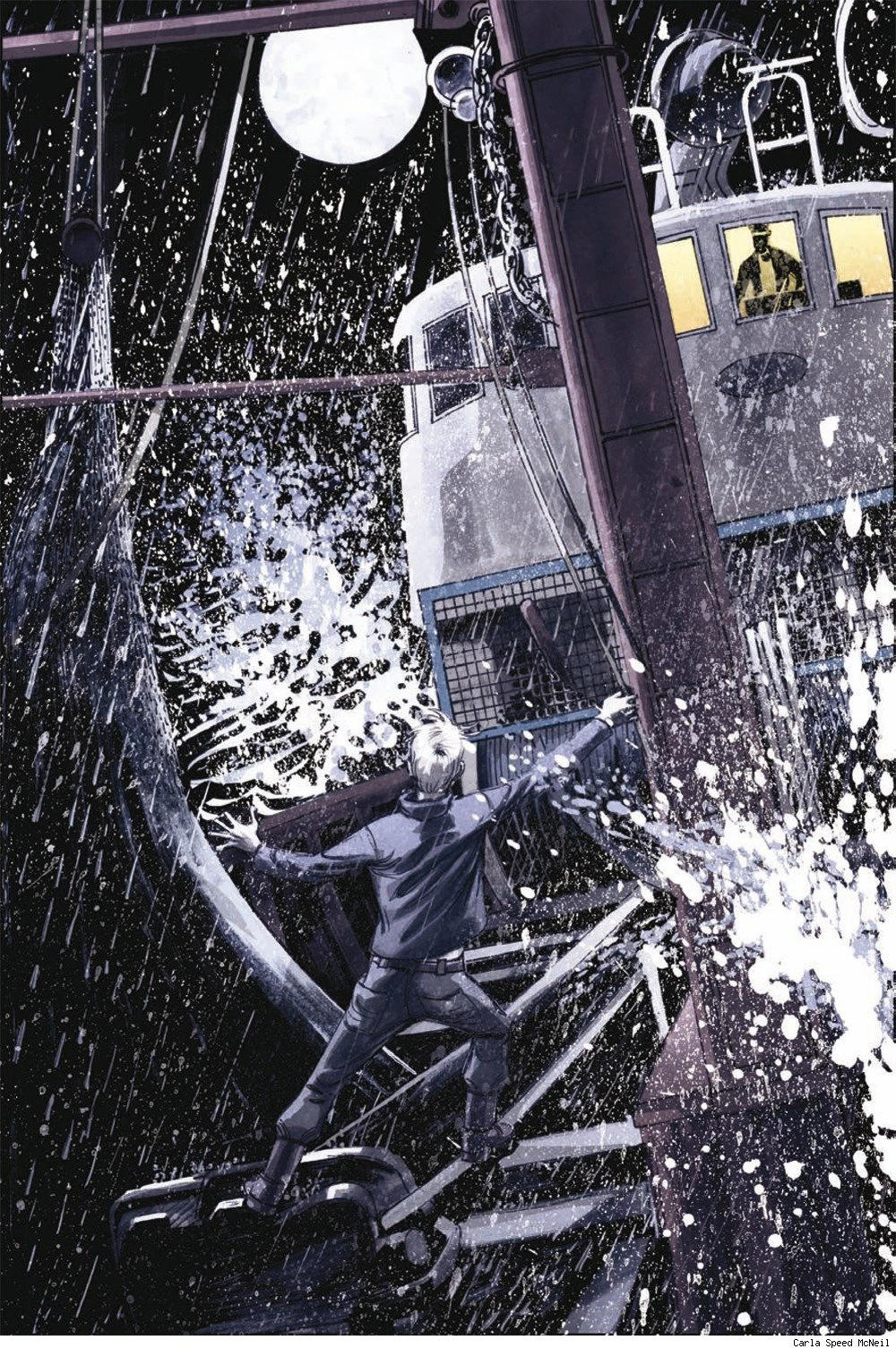![Dark Horse Collects Alex de Campi’s Poli-Spy Kickstarter Hit ‘Ashes’ [Interview]](http://townsquare.media/site/622/files/2013/04/smkash-tpb-fc-sol-1365891394.jpg?w=980&q=75)
Dark Horse Collects Alex de Campi’s Poli-Spy Kickstarter Hit ‘Ashes’ [Interview]
 A sequel to the Eisner-nominated 2005 limited series Smoke (with artist Igor Kordey), writer Alex de Campi's graphic novel Ashes was one of comics' bigger Kickstarter successes, raising over $32,000 in 2011 via the increasingly influential crowd-funding platform. But disaster struck when de Campi and her Ashes collaborator Jimmy Broxton (aka James Hodgkins) parted ways in acrimonious and public fashion before the dystopian poli-spy book was completed, causing some backers to ask for refunds. But most didn't, and the project became even more intriguing when de Campi announced she'd secured an impressive roster of auspicious replacement artists including RM Guerra, Colleen Doran, Igor Kordey, Dan McDaid, Richard Pace, Tomer Hanuka and Bill Sienkiewicz, all of whom illustrate separate chapters of the 250-page graphic novel.
A sequel to the Eisner-nominated 2005 limited series Smoke (with artist Igor Kordey), writer Alex de Campi's graphic novel Ashes was one of comics' bigger Kickstarter successes, raising over $32,000 in 2011 via the increasingly influential crowd-funding platform. But disaster struck when de Campi and her Ashes collaborator Jimmy Broxton (aka James Hodgkins) parted ways in acrimonious and public fashion before the dystopian poli-spy book was completed, causing some backers to ask for refunds. But most didn't, and the project became even more intriguing when de Campi announced she'd secured an impressive roster of auspicious replacement artists including RM Guerra, Colleen Doran, Igor Kordey, Dan McDaid, Richard Pace, Tomer Hanuka and Bill Sienkiewicz, all of whom illustrate separate chapters of the 250-page graphic novel.
Indeed, de Campi told ComicsAlliance that in a way the "drama" with Ashes was the best thing that could have happened, because with the book's higher profile came the attentions of Dark Horse, who will be reissuing to the mass market both Smoke and Ashes in a single, massive paperback volume later this year. Distinct from the limited edition hardcover that Ashes' Kickstarter backers are entitled to, Dark Horse's Smoke/Ashes is just the first of several planned projects from de Campi, including what she describes in this interview as a sex-and-violence exploitation series, another project with Sienkiewicz, and a new superhero comic to be drawn by Jerry Ordway.
Additionally, de Campi discussed in very candid terms the many pros and cons of a Kickstarter campaign, and her hard won wisdom for creators who might wish to explore the crowdfunding landscape.Originally released by IDW Publishing, Smoke was the harrowing adventure of Cain, a soldier-turned-assassin, and Katie, a plucky journalist with a penchant for getting herself into trouble, as they navigated danger, conspiracy and political intrigue in a dystopian world with super spies, oil billionaires and terrorists obsessed with their own good looks. The mood of the piece was something of a cross between Transmetropolitan and Yes, Minister, and earned de Campi quite a lot of praise, including an Eisner nomination for Best Limited Series.
Set five years later, Ashes finds Katie and Cain pursued by a dangerous teenage enemy and his father as punishment for bringing down the government in Smoke. The action takes the pair through a dark future of London and all the way to an army base in America, where things get even worse.
Ashes was completed and released in five digital chapters for Kickstarter backers whose pledges entitled them to early access, and the delayed Kickstarter-exclusive hardcover collection -- upgraded significantly from its original design -- is expected to ship to eligible backers later this year.
Ashes covers
ComicsAlliance: The last time we spoke, you'd parted ways with your original Ashes collaborator and had taken on several high profile replacements including Igor Kordey, Carla Speed McNeil, Bill Sienkiewicz, Richard Pace, and Colleen Doran. How did the rollout of all that content and the Kickstarter rewards go?
Alex de Campi: Ashes was both incredibly difficult and very rewarding. In some ways the collaboration split was the best thing that ever happened to me. Managing a dozen very busy artists and colorists and lettering a book and paying them is not something I ever want to do again, though. Everyone was great to work with -- all total professionals. I am just not a manager. Or a marketer. I'm a writer.
As far as rewards, we've sent out most everything except the book, and the higher-value art rewards. Dark Horse became interested in the book and will be putting out a huge, combined Smoke/Ashes trade in September so I am piggybacking my limited-edition hardcover run for backers on top of that. So the book is nine months late (I'd hoped to have it in people's hands by mid December 2012, but there were a couple art delays), but it will be twice as big. We also serialized the chapters of Ashes digitally to backers via Comixology, so those who wished to read the book online have already done so.
CA: Can you elaborate on the "piggybacking" remark? What is it backers are getting and what is it Dark Horse is selling?
ADC: Backers are getting a 1,000-copy hardback edition. Dark Horse are printing a big paperback trade edition. The way the printing process works is as long as the guts of the book are the same, it is very easy/cheap to change the cover stock. (Or indeed even add a case, as we are doing with the limited edition version). So rather than me sending out a print order to a separate printer, I'm paying Dark Horse to add my print order on to theirs. This has the effect of getting the backers a bigger book with much higher print quality, and for me means the cost of printing is actually about half compared with the stand-alone estimates I had received.
The main Ashes rewards were:
1) Backers-only serialization of the book digitally via ComiXololgy. ACHIEVED!
2) A 1,000-copy hardback edition of the book. IN PROGRESS! Downside: Late (coming September 2013 rather than December 2012). Upsides: Twice the book! Better print quality (cased)! I'm signing all of them!
3) The hardback, with signatures of most/all the artists. Limited to 200 books. IN PROGRESS! Setback: F***ING ROYAL MAIL LOST THE BOOKPLATES. Action: I'm reprinting them bigger and re-sending via FedEx. Also, crying myself to sleep.
CA: I was impressed by how many artists were keen to work on Ashes. Did the Kickstarter's notoriety help you in that regard, or did you already have relationships with the new Ashes artists? Surely it was easier to get lots of these busy people to draw smaller chunks than the whole 250+ pages.
ADC: On the art side, I do think a big attraction for the artists was that the chunks were fairly small, ranging from eight pages through to about 50. The deadline was also very long. Nobody was really in it because of the Kickstarter drama... in fact several artists were completely unaware of it. I know Carla Speed McNeil didn't know about all the drama until she was done her pages.
And... people liked the script. Heaven knows nobody was in it for the measly $70/page. I don't know what it is about what I do, but somehow my scripts appeal to the sort of artists whose line appeals to me. And several other projects have grown out of the friendships/collaborations that happened in Ashes. Carla Speed McNeil and I are planning a series together (which I always describe as Lost, if it was all teenagers, and directed by Sam Peckinpah... even though I've only ever seen one episode of Lost). Bill Sienkiewicz wants to draw my psychological/horror book Margaret The Damned (his first British-set work since Big Numbers, so... no pressure)... and once Dan McDaid stops being so darn busy we definitely want to work together again.
Ashes art
CA: How did Dark Horse come into the picture?
ADC: This is a bit of a shaggy dog tale. I'd worked with [Dark Horse Executive Editor] Diana Schutz some years ago on a couple anthology titles and I had stayed in touch with her then assistant, Brendan. I'd pitched him a few things... nothing really fit, and I felt that maybe my work just wasn't a fit for them. But Jeff Parker was like, no, they're excellent, keep at it. And I had just written two big, really hard books in a row: Ashes, then Margaret The Damned. I was noodling around working out what to write next. (I try to write two hours a day, every day, and go into withdrawl if I don't have a project on the go).
I was dithering between a couple more ideas that would have been big, serious books and realized that I just didn't have it in me. I was completely drained from Ashes' production and the demands of writing the very, very dark script for Margaret. So I started screwing around on Twitter, as you do, talking about how I was burned out and just wanted to write crazy exploitation stuff like Bee Vixens From Mars, a title I made up on the spur of the moment. Twitter responded overwhelmingly: WRITE GONZO EXPLOITATION! Lots of people wanted to read something called Bee Vixens From Mars. I wrote a quick pitch, dragooned in some old friends (Si Fraser and Federica Manfredi) and some new ones (Gary Erskine and Chris Peterson) on art chores, and sent it off to a couple publishers: eight issues, comprised of four two-issue standalone grindhouse/exploitation series. I included the script for the first part of Bee Vixens.
Brendan got back to me within 48 hours. The series was approved by the end of the week. It happened so fast as to feel unbelievable. A year, eighteen months of nothing, nothing, nothing, then I just hit it. Dan Goldman has a joke based on his experiences pitching his book Red Light Properties to Hollywood: "Protip: More Tits." I'd been pitching all these big literary books, no response. Gratuitous nudity, gore and over the top badassery? Boom, approved.
(Not to look down on exploitation writing. It's very hard to walk that line effectively, without the end result being horrible. As a writing exercise, it completely rejuvenated my enthusiasm for, well, everything. Plus: of course her shotgun is gold-plated. Of course there is an erotic pie fight. Of course they all ride mopeds. Et cetera.)
ADC: Do you know how much fun we had making the grindhouse series, though? All the fun. ALL OF IT. If you notice less fun in the world in the next few months, it's because we took it. And we're not sorry. Nolan Woodard, who is colouring Chris' Bee Vixens art, messaged me the other day, saying, "You know I colored 28 Days Later, right? And this is still WAY more blood."
Anyway, we got Grindhouse under way. Then at NYCC I met Brendan in person, and Scott Allie came over to Rachel Deering and my booth waaaay out in Siberia just as a 20-something reader was getting the pitch for Ashes and getting super enthusiastic about it. That started a discussion about Smoke and Ashes, and then after a month or so of discussion, that happened.
CA: What's it been like working with Dark Horse? Following up on your remark about all the extra work you had to do besides writing, I'm curious to know what the publisher brings to the table in a situation like this.
ADC: I am not a natural self-publisher. I really don't enjoy any of the aspects of it other than writing, working with artists, and lettering. Everything else, no thank you. Thanks to Dark Horse, I have editors. And proofreaders. And production staff who, unlike me, actually know what they are doing, and how to set things up for the printer. And warehouses. And a PR team. And big shiny booths at conventions so I don't have to get my own table. And distribution! And relationships with stores. And a reputation for quality.
CA: I believe you're working on some other things too?
ADC: I've now fallen into a quite comfortable working pattern of one very serious book, then one lighter/sillier project. I've just finished the script for a big thriller that Ramón Pérez loves, and there will be a separate but related thriller that I'm hoping Dean Haspiel will draw. He's an old friend, and we've always talked about a project... in between, I'm noodling around with a gonzo teen girl book with Eva Cabrera, and a Moebius-inspired sci fi middle grade girls' adventure book with Paul Tucker.
CA: So Ashes and Smoke and the gonzo book are at Dark Horse. Are these other projects you're talking about set up anywhere, or are they still in development?
ADC: Smoke/Ashes will be one book, at DH. The Grindhouse series is DH. The other books, the series with Carla is likely to be Dark Horse though it's not finalized yet. The book with Bill, we've got a couple options and are still exploring them -- basically we need to get on the phone sometime this week. The teen and middle grade books are either sitting with publishers awaiting a response, or we have a pretty good idea where they will go. The thing with Ramón I haven't really started pitching out yet (though the script is done) because I'd also like to write the related script for Dino and pitch them as a pair.
CA: Can you tell me anything about the Jerry Ordway project you''ve mentioned before? You two don't strike me as a natural pairing given your disparate backgrounds in terms of genre and such. How'd you get together?
ADC: He's an artist I've always admired. Just because I don't write superheroes doesn't mean I don't like the mainstream. Of course some of it is tiresome, but the best superhero writing and drawing stands with the best of all sequential work, full stop. We're both slammed with work until May, and then we're going to start bouncing ideas around. It will likely be a Dark Horse Presents project for next year. My only consideration is that I'd like it to be a story that is ultimately quite positive and life-affirming. And which I can write to make the most of Jerry's prodigious artistic skills.
CA:I It sounds like you're unlikely to go the Kickstarter route again, despite being one of the more successful comics projects to raise funds with the platform.
ADC: I actually think I would do another Kickstarter again, but for a project with fewer moving parts... and possibly as many creators already do, with Image or someone like that signed on to handle the publishing side. The great difficulty with Ashes was the stress/drama of dealing with the first collaborator's attitude and then departure, and then the sheer effort in dealing with a dozen artists and colourists. Although all the new artists were as lovely as could be, just emailing and chasing them up took a huge amount of time. I was also (and remain) cripplingly broke, and a single mom of a toddler. These are both exhausting situations in and of themselves.
For the longest time, I thought I would be doing another Kickstarter for Valentine (my half-completed webcomic) this May. However I think I've found a partner/investor that will keep me from having to do that. But, you know, nobody might pick up the book with Bill. Or someone may, but we might decide we also want to do a really high-spec edition, like Steven Sanders is doing with his book Symbiosis. There are only about five legit publishers for good independent comic work, and if you really believe in a project you always have to be prepared to deal with what happens when it's not right for any of them.
Ashes art
CA: Having been through it, what advice would you have for other published creators considering taking their next project to Kickstarter?
ADC: Herewith Alex's top tips for Kickstarterage.
First is ask for as little money as you can possibly get away with. That doesn't mean under-funding yourself (your project will cost half again as much as you think, anyhow), it means aiming low. Got a 200 page book? Consider breaking it into three parts. Really, try not to aim for much over $10k. If you get more? Awesome. But I have seen some great projects by known creators totally not get off the ground. Kickstarter is not a magic money tree.
Second, the project will take twice as long and cost half again as much as you expect. Plan on that. Ars longa, vita brevis, which is Latin for "your artist will blow your deadline and give you grey hair."
Third, be very honest with your backers. If things are going wrong or you are running late, tell them early on, and tell them what steps you are taking to sort it out. When everything hit the fan with my former collaborator, I offered refunds to anyone who wanted them. We refunded about $400 worth of pledges, and then as we signed up new artists, got about $1200 more in orders. Honesty and clarity is very, very important. Also, responding quickly and politely to any queries from backers is crucial. If someone disagrees with you or doesn't like what you are doing, don't take the high hat with them -- I shouldn't have to say this but I've pledged for a couple Kickstarters where the creators acted like such tools if there was the slightest criticism, I've vowed never to buy their work again. Remember that not all your backers read your updates, so put the salient information that people ask for repeatedly (when's the book coming out? etc) up at the top.
Fourth, and I call this the Sullivan's Sluggers Memorial Rule, is don't let success go to your head. If you raise a crapton of money, do not print many thousands of books more than you need. If you are that successful, call Image. Speak to a publisher. Get them to print it. If that doesn't work, print a maximum of 500 over what your backers have ordered. That's it. Don't get stuck with stock.
Other than that, it's just commonsense stuff. Have a lot of preview art (10 pages+). Try to get quotes from writers and artists people have heard of endorsing your work. Don't spam people on twitter (mention your project twice a day, max). Have a tangible object as a reward (also known as, a "book"). Don't fundraise for six issues of a comic, but only offer Issue 1 as a reward. Realise that the month your Kickstarter is active, it will take up 50-100% of your time. Realise also that your Kickstarter is not newsworthy in and of itself and if you are going to contact journalists make sure you provide an angle other than "I am trying to raise money and please give me some free PR!"
Dark Horse's collection of Smoke/Ashes goes on sale this July.
More From ComicsAlliance
![The Cats Deserve Their Fame: Ananth Hirsh and Yuko Ota Dive Back Into ‘Johnny Wander’ [Interview]](http://townsquare.media/site/622/files/2017/03/JWOMNI-COVER-ONI-PRESS-EDITION-4x6-COMP-CA-FEATURED-IMAGE.jpg?w=980&q=75)
![Steven Andrews Offers a Tour Of Toronto In ‘Yonge at Heart’ Anthology [Back Pages]](http://townsquare.media/site/622/files/2017/03/yongeatheart-feat.jpg?w=980&q=75)

![Hanging Out With Flair, Being Best Friends With ‘The King': Mike Kingston’s Absurd Journey to ‘Headlocked: The Hard Way’ [Interview]](http://townsquare.media/site/622/files/2017/03/HTHW-Promo-2.jpg?w=980&q=75)
![Bill Sienkiewicz Provides FOC Variant Cover For ‘American Gods: Shadows’ #2 [Exclusive]](http://townsquare.media/site/622/files/2017/03/AMGODS0.png?w=980&q=75)

![Show Your Cards With Queer Tarot Anthology ‘Tabula Idem’ [Back Pages]](http://townsquare.media/site/622/files/2017/02/TI2.png?w=980&q=75)

![Damian Duffy Helps Shines A Spotlight In ‘Black Comix Returns’ [Back Pages]](http://townsquare.media/site/622/files/2017/02/blackcomix-feat.png?w=980&q=75)

